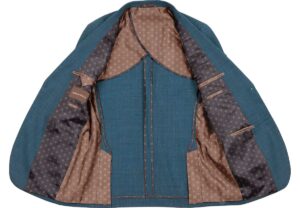Creating a jacket lining mockup can be a fun & rewarding project for anyone interested in fashion design. A mockup helps designers visualize the interior design of a jacket before actual production. This process saves time and resources and ensures that the final product meets expectations. In this blog post, we will explore what a jacket lining mockup is, its key features, benefits, and importance, as well as provide a step-by-step guide to creating one.
What is a Jacket Lining Mockup?
A jacket lining mockup is a digital representation of the inner fabric of a jacket. It allows designers and clients to see how the lining will look before it is sewn into the jacket. Think of it as a blueprint for the inside of your jacket. This mockup can be created using PSD (Photoshop Document) templates, which provide editable layers to customize the design.
Key types of jacket lining mockups include:
- Suit Lining Mockup
- Suit Jacket Mockup
- Jacket Lining PSD Mockup
Fashion designers, e-commerce sellers, and anyone involved in custom apparel designs often use mockups. They help envision design ideas and make adjustments without the need for physical samples.
Key Features of Jacket Lining Mockup
Creating a jacket lining mockup involves several features that make the process efficient and effective. Here are some key features to consider:
- Editable Layers: Allows easy customization of colors, patterns, and textures.
- Smart Layer: This enables you to insert your design effortlessly & see how it looks in a realistic setting.
- High-Quality Realistic Images: Ensures that the mockup appears as life-like as possible.
- PNG Images: Offers transparent backgrounds, making integrating the mockup into other designs easier.
- File Types: Common file types include PSD, PNG, and JPEG, making them versatile for various software.
- Online Editor: Some platforms offer an online editor, making creating mockups without specialized software easy.
- Customizable Patterns: Allows for the creation of repeatable patterns and fabric textures.
- Transparent Design: Ensures the mockup can be placed on different backgrounds without losing quality.
- Design Details: Includes placeholders for labels, tags, and other details.
- High-Quality Template: Provides a professional look and feel for presentations.
Benefits of Using Jacket Lining Mockup PSD
Using a jacket lining mockup, PSD offers several benefits:
- Visualization: Helps in visualizing the final product before production.
- Cost-Effective: Reduces the need for physical samples, saving time and money.
- Customization: Allows for easy adjustments and changes to the design.
- Presentation: Provides a professional way to present design ideas to clients or stakeholders.
- Error Reduction: Helps identify potential design flaws before they become costly mistakes.
The Importance of Jacket Lining Mockup
The importance of a jacket lining mockup cannot be overstated. Here’s why:
- Efficiency: Speeds up the design process by providing a clear visual guide.
- Accuracy: Ensures that the final product matches the design specifications.
- Communication: Facilitates better communication between designers, clients, and manufacturers.
- Innovation: Encourages creative exploration and experimentation with different design elements.
- Market Readiness: Helps create marketing materials and presentations for potential buyers or investors.
How to Use Jacket Lining Mockups
Using a jacket lining mockup is straightforward if you follow these steps:

Step-by-Step Guide to Creating Jacket Lining Mockup
Step 1: Choose the Right Template
- Select a Jacket Lining Mockup PSD template that suits your needs.
- Ensure the template has editable layers and smart objects for easy customization.
Step 2: Open the Template in Photoshop
- Open the PSD file in Adobe Photoshop.
- Familiarize yourself with the layers panel to understand the structure of the mockup.
Step 3: Customize the Design
- Double-click on the smart object layer to open it.
- Add your jacket lining fabric design, patterns, or textures.
- Save the smart object layer and return to the main template.
Step 4: Adjust Colors and Textures
- Use the color adjustment tools to tweak the colors of the lining.
- Apply textures to give a realistic feel to the lining fabric.
Step 5: Add Labels and Tags
- Insert suit jacket label mockup designs to show where labels will be placed.
- Customize the text and logos as needed.
Step 6: Save and Export
- Save your work to preserve the editable layers.
- Export the final mockup as a high-quality PNG or JPEG file.
Step 7: Review and Present
- Review the mockup for any errors or adjustments needed.
- Present the mockup to clients or stakeholders for feedback.
The Future of Jacket Lining Mockups
As technology advances, the future of jacket lining mockups looks promising. Here are some trends to watch:
- Enhanced Realism: Improved rendering techniques will make mockups even more life-like.
- Interactive Mockups: Using augmented reality (AR) to create interactive mockups.
- AI Integration: AI-powered tools to automate the customization process.
- Online Platforms: Increased use of online editors for creating mockups without needing specialized software.
- Sustainable Design: Focus on eco-friendly materials and sustainable design practices in mockups.
Also See>>>>> Shirtsmockup
Conclusion
Creating a jacket lining mockup is essential for anyone in fashion design. This practice offers benefits like visualizing ideas and saving time and money. By crafting a detailed mockup, designers can see how fabrics, patterns, and colors will look in the final product, allowing for adjustments before production. Mockups also help identify construction challenges early, ensuring a smoother manufacturing process.
Following this guide, you can create professional, realistic jacket lining mockups to impress clients and stakeholders. A well-executed mockup showcases your creative vision and attention to detail. Embrace mockups to refine your concepts and present polished representations of your ideas.



No Comment! Be the first one.